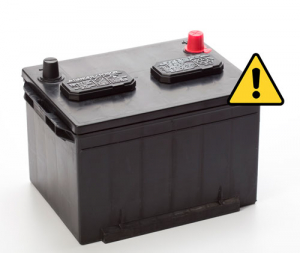Battery Hazards
Batteries are hazardous because of their stored energy as well as the materials they are made from. When dealing with an off-grid or hybrid PV system, always note the location of the battery storage system as well as the place where conduit enters the building to reach it.
Never cut into a battery! Any conductive object that punctures a battery should be treated as if it is energized.
Batteries do not burn easily, but in a fire, they can release electrolyte, which is corrosive. Toxic fumes and flammable and explosive gases may be produced as the battery deteriorates.
Take these precautions to stay safe from hazardous battery materials:
- Handle spilled electrolyte appropriately and with caution.
- Prevent open flames and avoid creating sparks, in case of explosive gases.
- Always wear full PPE and SCBA.
- Treat battery involvement as a hazardous materials release.
- If batteries are generating vapor, electrically isolate them and move to a safe position on the corner of the structure.
Please see the next module to learn more about battery hazards and response tactics for incidents involving residential, commercial and utility-scale battery energy storage systems (BESS).


